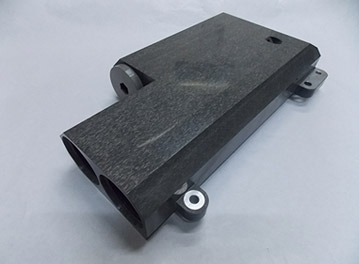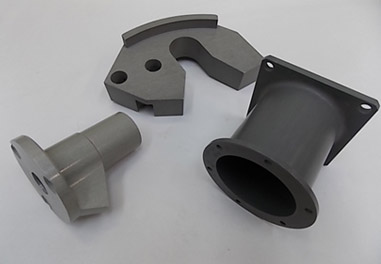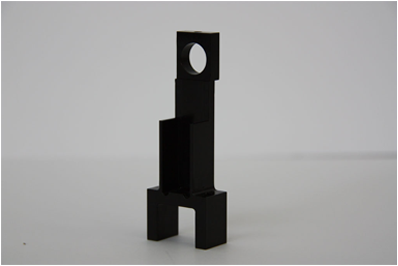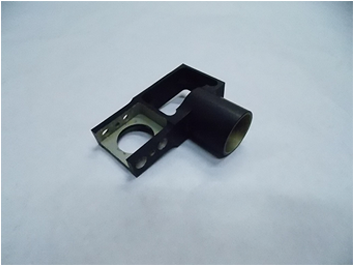The aluminum anodic oxidation
The aluminum anodic oxidation (or anodizing) is perhaps one of the most common plating processes in the world and covers areas ranging from architecture to aeronautics, from sports gear to space, from mechanics to electronic, for purely decorative applications or functional ones.
The process consists in an aluminum surface transformation into aluminum oxide, by the immersion of the parts to be treated in an acidic solution where occurs a passage of direct current, with objects which works as the anode (positive pole): the atomic oxygen that is developed during the current flow combines with the aluminum atoms forming an oxide the whose growth is controlled, with an improvement of the properties comparing with the oxide that is formed in a natural way.

Examples of colored anodizing in civilian applications with aesthetic requirement
The oxide structure as such it’s porous and for the majority of applications requires a subsequent treatment, known as "FIXING" or "SEALING": it’s a pass in deionized water or in aqueous solutions (based, for example, of nickel salts or dichromate) with high temperature where an oxide hydration happens and the increase in volume that derives closes the porosity, up to obtain a solidly sealed layer.
The fastening (or sealing) is critical to have the maximum resistance to corrosion and hence the durability of the treated parts: in the case of colored layers, the color resistance is greatly improved also If exposed to the sunlight; by contrast there is a reduction of the surface hardness and of the abrasion/wear resistance.
It is therefore important that the customer gives the galvanic precise information about the use of the objects to be treated.
General Feature: the oxide layer obtained is not electrically conductive
The main purposes of anodic oxidation are:
- To increase resistance to corrosion;
- To confer a greater surface hardness;
- To improve the wear/abrasion resistance;
- To impart a lasting good appearance over time.
The anodization can be:
Natural (colorless): normally it keeps the typical color of the aluminum, but it may take more or less intense natural colors as a function of the treated aluminum alloy;
Colored: the coloring is achieved by simple immersion of the anodized aluminum (not yet set) in suitable dye solutions, without electric current: the dyes enter the pores of the aluminum oxide and form true chemical bonds of various kinds; to obtain the best results, especially in the darker shades (for example black), oxide thicknesses of at least 15μ are needed.
The pigment can be of organic or inorganic nature: organic ones offer a wide range of colors and are the most universally used; the range of inorganic colors (based on metal hydroxides) are very limited (normally black): they find application mainly in the space sector (ensuring the absence of vacuum degassing) and generally offer a higher light and heat solidity..
> THE CHOICE OF ALUMINIUM AND ITS ALLOYS TO BE ANODIZED
When you have to anodize an aluminum object remember a simple and essential concept:
it is not true that any type of aluminum is good for anodizing and an excellent alloy for machining it is the same for the galvanic treatment!
The anodic oxidation process is sensitive to the quality and type of alloy used for the manufacture of the objects to be treated (much more than for any other galvanic treatment).
We recommend the procurement from qualified suppliers asking the quality of anodizing.
It is important the uniformity in composition of an alloy, as well as the thermal state, the conditions of extrusion or lamination, the conditions of storage (possible beginnings of corrosion) and mechanical processing (for example localized overheating): are all variants which may be the cause of defects of the treatment (streaks, speckles, variations in thickness between adjacent regions, ...), which are not visible at the origin.
Here, by way of explanation, we report what is recalled by the standard "MIL-A-8625 - Anodic coating for aluminum…":conditions, displacement of the chemical composition of the alloy and inclusions, which may affect some of the requirements of this specification."
The alloys that are better suited to the anodizing treatment, especially for the final aesthetic aspect, are those of the 6xxx series (Anticorodal) and 5xxx (Peraluman).
The alloys with high mechanical properties, 2xxx series (Avional) and 7xxx (Alu), mainly used in the aerospace industry, are treatable with suitable anodizing cycles that favor the functional specifications, sometimes at the expense of the aesthetic characteristics (especially when the quality alloy used is not sufficiently guaranteed).
> THE THICKNESS OF THE OXIDE LAYER
Lack of knowledge of the mechanism of formation of the anodization layer often leads to misunderstandings between the electroplating and the machine shop when details with tight tolerances are discussed.
There is a substantial difference between any galvanic treatment (nickel, zinc, silver, gold... on any base material) and aluminum anodizing: in the first instance the thickness applied grows all over the base material and then the dimensional variation introduced by the treatment is easily calculable, but for the anodizing the mechanism is different:
- the oxide that is formed in part grows above the base material (aluminum) and partly penetrates inside, then the dimensional variation of an anodized piece will be due solely to the portion of "external" oxide; which, based on experience gained over time with several dimensional checks, it represents 30-35% of the total thickness (about 1/3).
- Example: consider an anodizing of 15μ thickness: the outer growth is 5μ a wall, then with a dimensional variation of the mechanical portion of 0.01mm.
> DIFFERENT TYPES OF ANODIZING
There are 3 types of anodizing:
- Chromic (obtained by chromic acid baths - Ref. MIL-A-8625, Type I or IB)
- Sulphuric (obtained from sulfuric acid baths - Ref. MIL-A-8625, type II)
- Hard (obtained from sulfuric acid baths with special working parameters - Ref. MIL-a-8625, type III)
> Chromic anodizing
Its main features are:
- Typical oxide thickness: 2-6μ (mechanical dimensions virtually unchanged)
- Minimum impact on the loss of resistance to fatigue of the Treaty article (lower then sulfuric anodizing)
- Good corrosion resistance (over 360 hours in salt spray, up to 500 hours depending on the type of fastener used)
- Not suitable for color (black only acceptable, but less intense than the sulfur)
- Poor resistance to wear and abrasion
 |
 |
|
|
Chromic anodization of alloy 2024 – Aerospace sector | Anodizzazione cromica su diverse leghe alluminio – Settore aerospaziale
The chromic anodic oxidation is primarily used for applications in the aerospace, defense and precision mechanics and it is particularly suitable for application in contact with explosives and propellants; in aerospace it is often used as a base (possibly without fixing or final sealing) for a subsequent painting.
In case of articles of complex geometry, with undercuts, recesses and blind holes, the chromic anodizing is preferable to sulfuric one for the less aggressive of the electrolyte on aluminum.
- The routinely treated alloys are the 6061-6082-2024-7075 type (the later two especially in aerospace and defense, thermal state T4, T6 and T73).
- Alloy containing more than 5% of copper or the 7% silicon or more binders with a total of 7.5% of the elements (ref. Standard MIL-A-8625) are not recommended.
Lead-containing alloys are absolutely not suitable, type 11S (2011).
> Sulfuric anodizing
Main features:
- Typical oxide thickness: 8-25μ
- Middle impact on loss of resistance to fatigue of the Treaty article (less then hard anodizing)
- Good corrosion resistance (over 336 hours in salt spray)
- Great for colors

Sulfuric anodizing yellow colored alloy in 2024 - by sector defense
 |
 |
Sulfuric anodizing Black |
Sulfuric anodizing inorganic black color, with chromed site (type Alodine) – Application space sector |
Sulfuric anodizing is the most common type for applications in various industries, including aerospace and defense.
For its high capacity to absorb a wide range of colored pigments it is also used in applications where appearance is of primary importance.
The process is applicable to any type of aluminum alloy (the 6xxx series alloys are still the most suitable for aesthetic uses).
> Hard anodizing
Main characteristics:
- Typical oxide thickness of 20 to 80μ (optimum range 40-60μ)
- Strong impact on the loss of resistance to fatigue of the treated manufactured article, with a reduction from 30 up to 60% of the initial resistance of the aluminum (more negative impact on alloys with higher initial resistance, type 2024 and 7075)
- Important increase in surface hardness
- High wear/abrasion resistance
- Good resistance to corrosion (over 336 hours in salt spray)
- Not suitable at all for coloring (the only available color is black)
![]()
Hard anodic oxidation on alloy 6082 - Applications Semiconductor Industry
The hard anodic oxidation is basically indicated for applications where the main requirement is the surface hardness and wear/abrasion resistance: the best performance are obtained with the anodizing without final fixation, with a thickness of no more than 50-60μ and possibly with a mechanical removal of about 20μ: resulting in a more compact and harder oxide layer.
If the main requirement is the corrosion resistance the final fixing is necessary, obtaining in any case a good compromise with the wear resistance.
The routinely treated alloys are the 6061-6082-2024-7075 type (the later two especially in aerospace and defense sectors, in thermal state T4, T6 and T73).
Alloy containing more than 5% copper or 8% silicon or with a total of 8% greater binding elements (ref. Standard MIL-A-8625) are not recommended.
Lead-containing alloys are absolutely not suitable, type 11S (2011).
COMPARATIVE TABLES
The following table shows the direct comparison of the main features of the three different types of anodizing (data collected by technical documentation retrieved from Web sites and from our experience):
| Characteristics | Chromic oxidation | Sulfuric oxidation | Hard oxidation |
| Typical thicknesses range | 2-8µ (1) | 8-25µ | 20-80µ (2) |
| Surface hardness Increased | Minimum | Moderate | High (3) |
| Wear resistance | Fair | Poor (4) | High (5) |
| Corrosion resistance | Good (6) | Good (6) | Good (6) |
| Oxide color (Without additional coloring) |
from colorless to greenish-gray (7) | From Colorless to yellowish-gray (7) | From light gray to brown/black (7) |
| Loss of resistance to fatigue of the treated alloy | Low | Medium | High (30-60%) (8) |
- Depending on the type of treated alloy;
- 40-60μ optimal;
- Ref. To 6082 alloy: from initial 100-120HV about 400-450HV;
- About 3 times that of aluminum;
- About 10 times that of aluminum (maximum values without final fixation, on 6xxx series alloys);
- With the final fixture;
- The color tones vary according to the type of treated alloy;
- The greatest impact is of high mechanical properties of alloys, 2024 and 7075.
In this other type table are compared some of the most commonly subjected to the anodizing treatment alloys, for a comparison between their main chemical-mechanical characteristics and their behavior in the anodizing process:
| Properties | 6061-T6 (*) | 7075-T6 | 2024-T4 |
| Tensile strength | 45 Psi / 350 MPa | 83 Psi / 550 MPa | 68 Psi / 450 MPa |
| Chemical composition (%)
Si / Fe / Mn / Cr Cu Zn Mg Other Aluminum (min) |
0.25 0.8-1.2 0.30 98.85 |
0.5 / 0.7 / 0.30 / 0.30 1.2-2.0 5.1-6.1 2.1-2.9 0.35 86.75 |
0.5 / 0.05 / 0.60 / 0.10 3.8-4.9 0.25 1.2-1.8 0.15 90.90 |
| Machinability | Fair | Good | Very good |
| Corrosion resistance | Very good | Fair | Poor to fair |
| Anode oxide quality | Very good, compact and good oxide and good resistance to wear. | Good, but less in wear resistance. | Fair/good, critical process for high % copper. |
| Suitability for different types of anodizing:
Chromic Sulphuric Hard |
Excellent Excellent Excellent |
Good (1) Good (1) Good (1) |
Good (1) Good (1) – No decorative Critical (2) |
| Special features and applications |
Very versatile alloy, economic, with excellent resistance to corrosion, but low strength. |
Among the most robust alloys, used for highly stressed articles.
Oxide similar to 6061 For applications requiring increased strength. |
Good robustness with high fatigue resistance, but lower resistance to corrosion.
Used for aeronautic structural components. |
(*) Characteristics and behavior similar to 6082 alloy (mostly used on the European market);
- With adoption of anodizing parameters personalized to the type of alloy;
- Even with suitable working parameters may occur local overheating, with damage to the oxide and/or of the base material, due to the presence of the copper inter-crystalline compounds.

 IT
IT  EN
EN 





